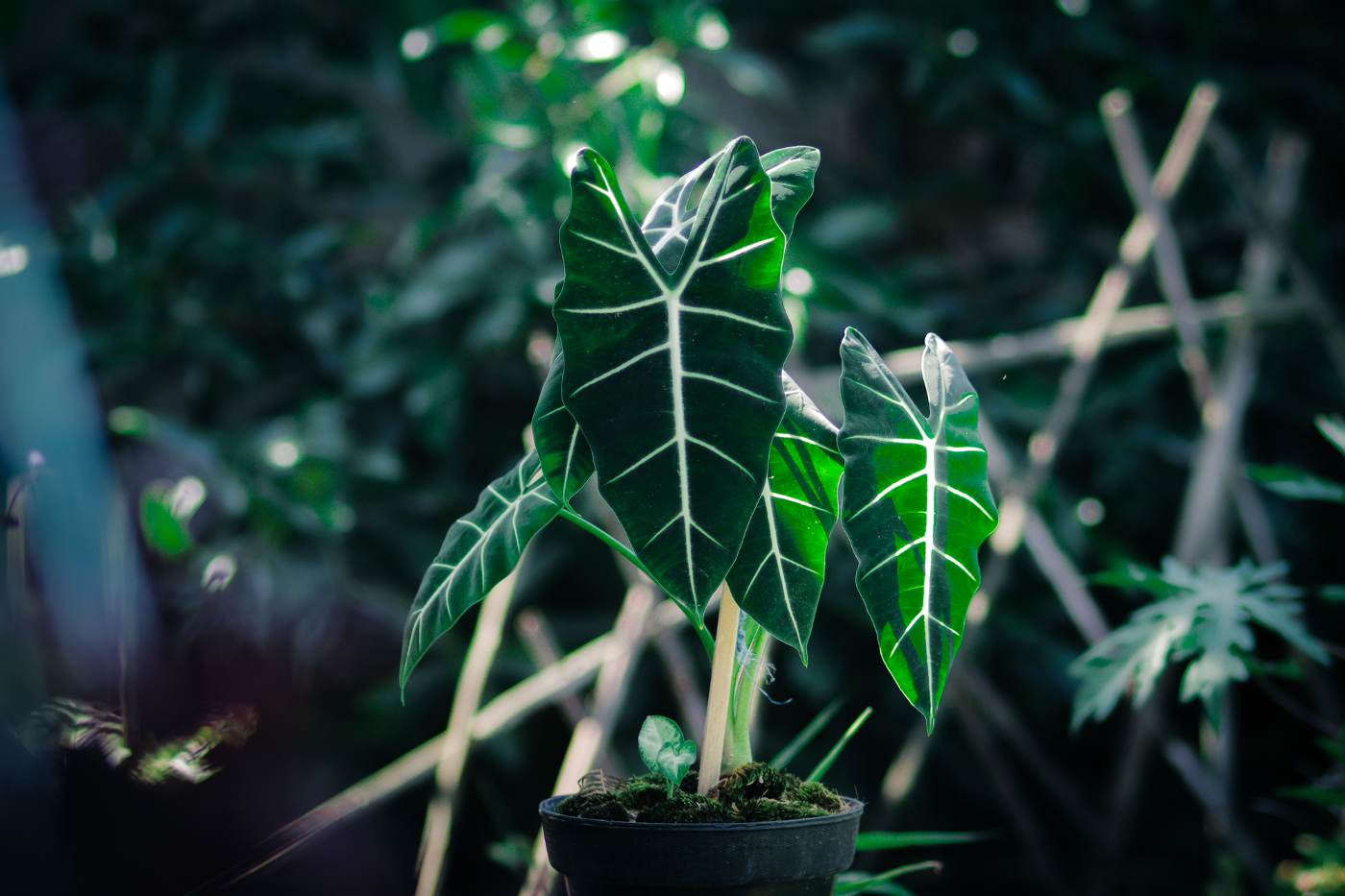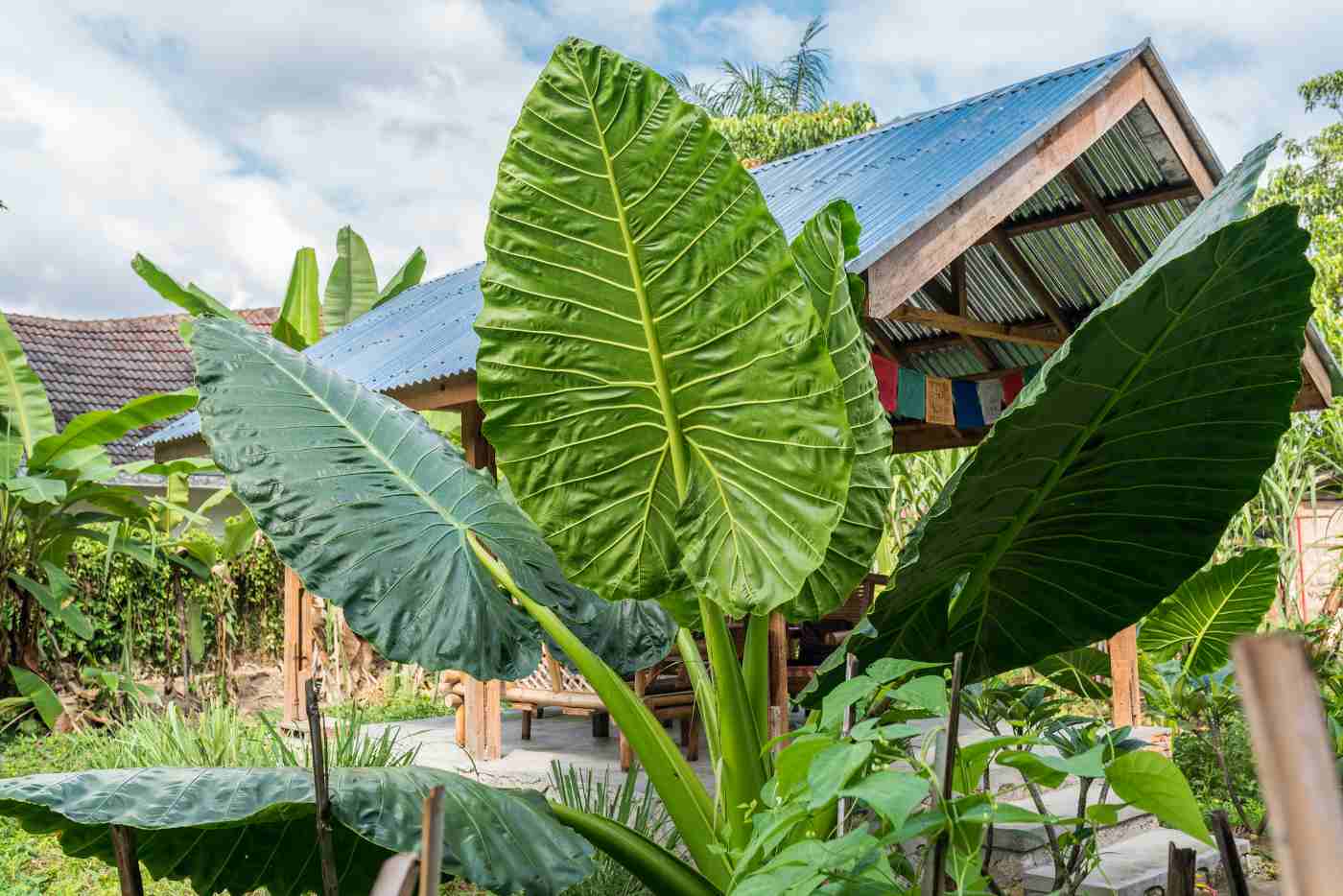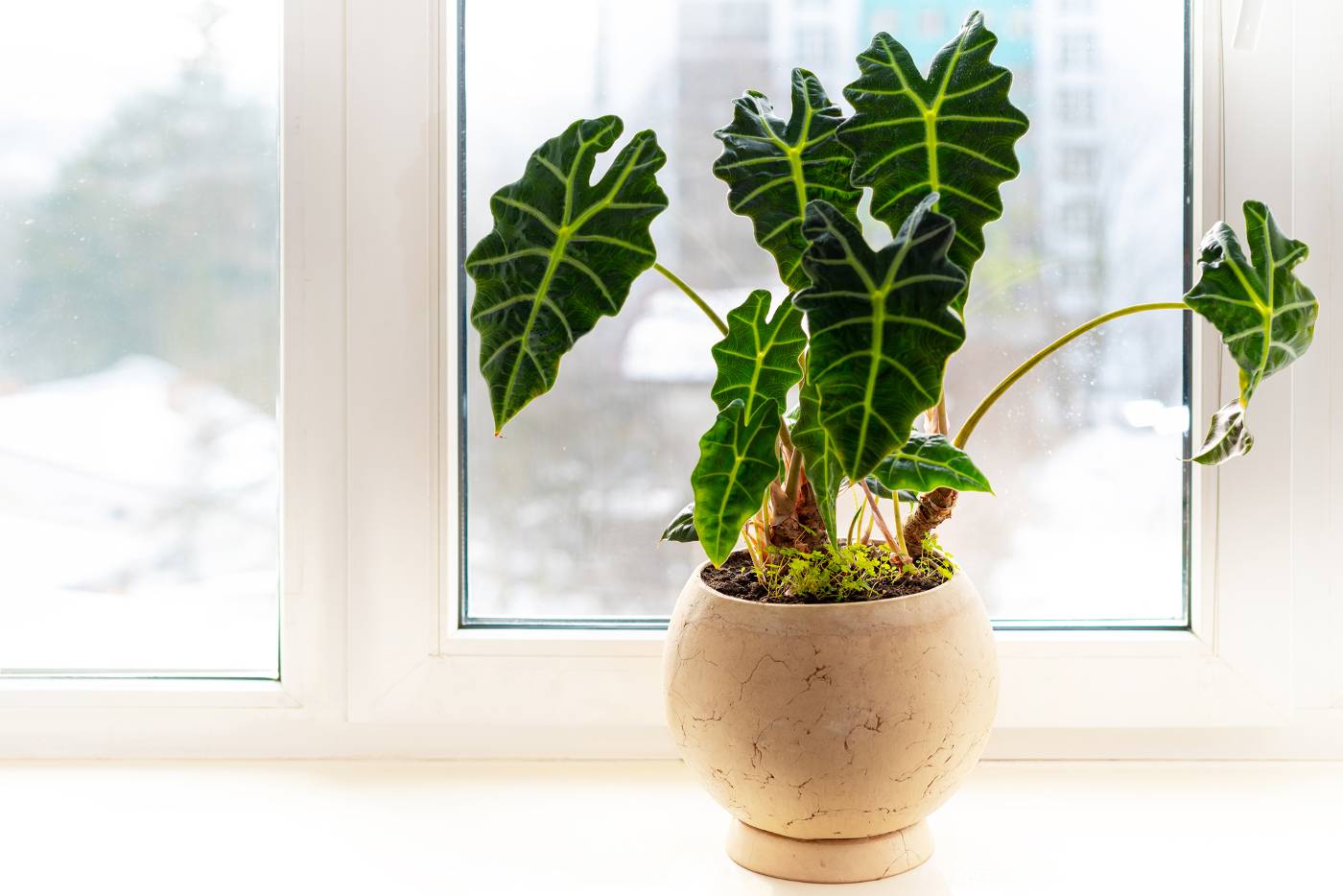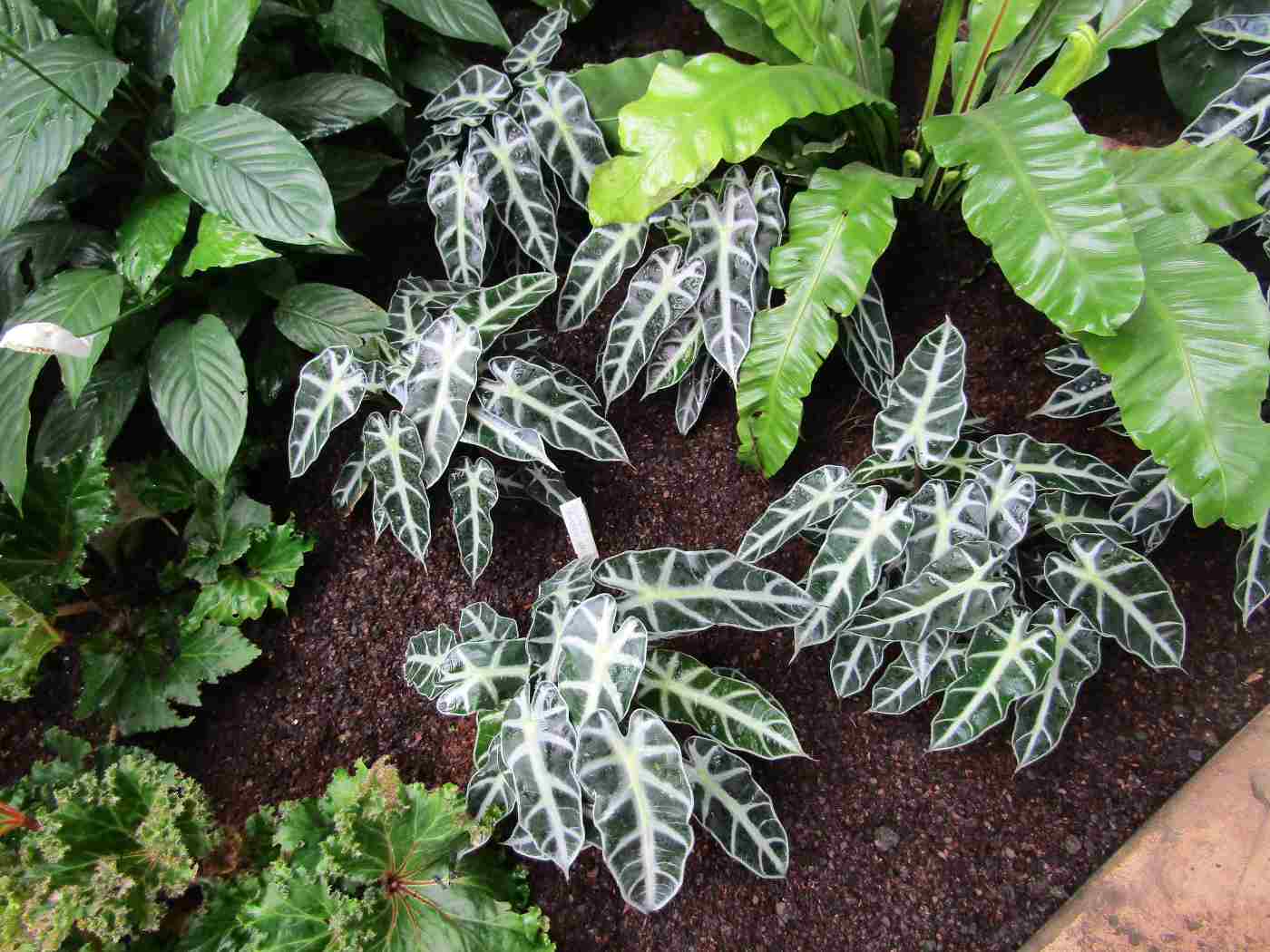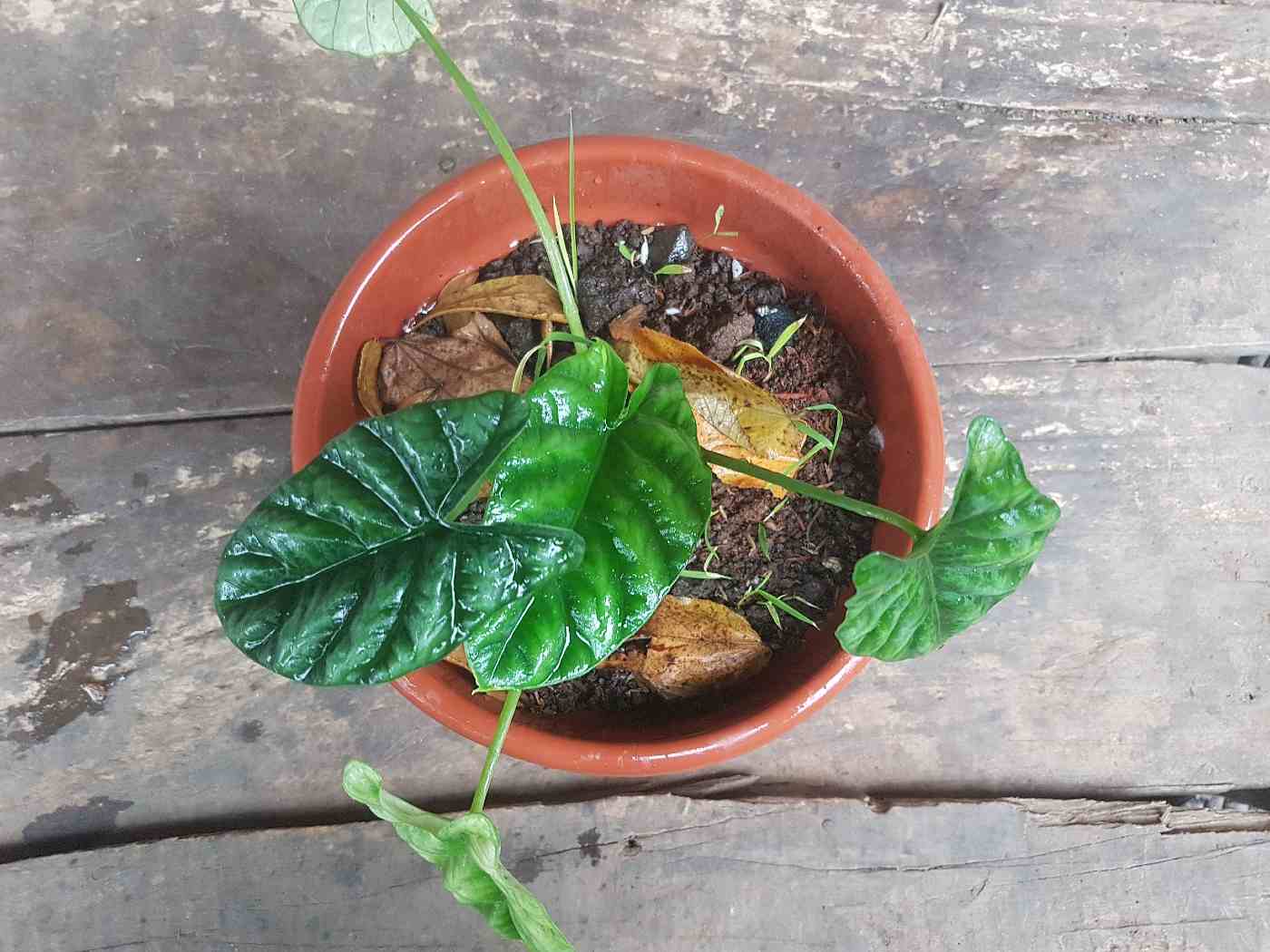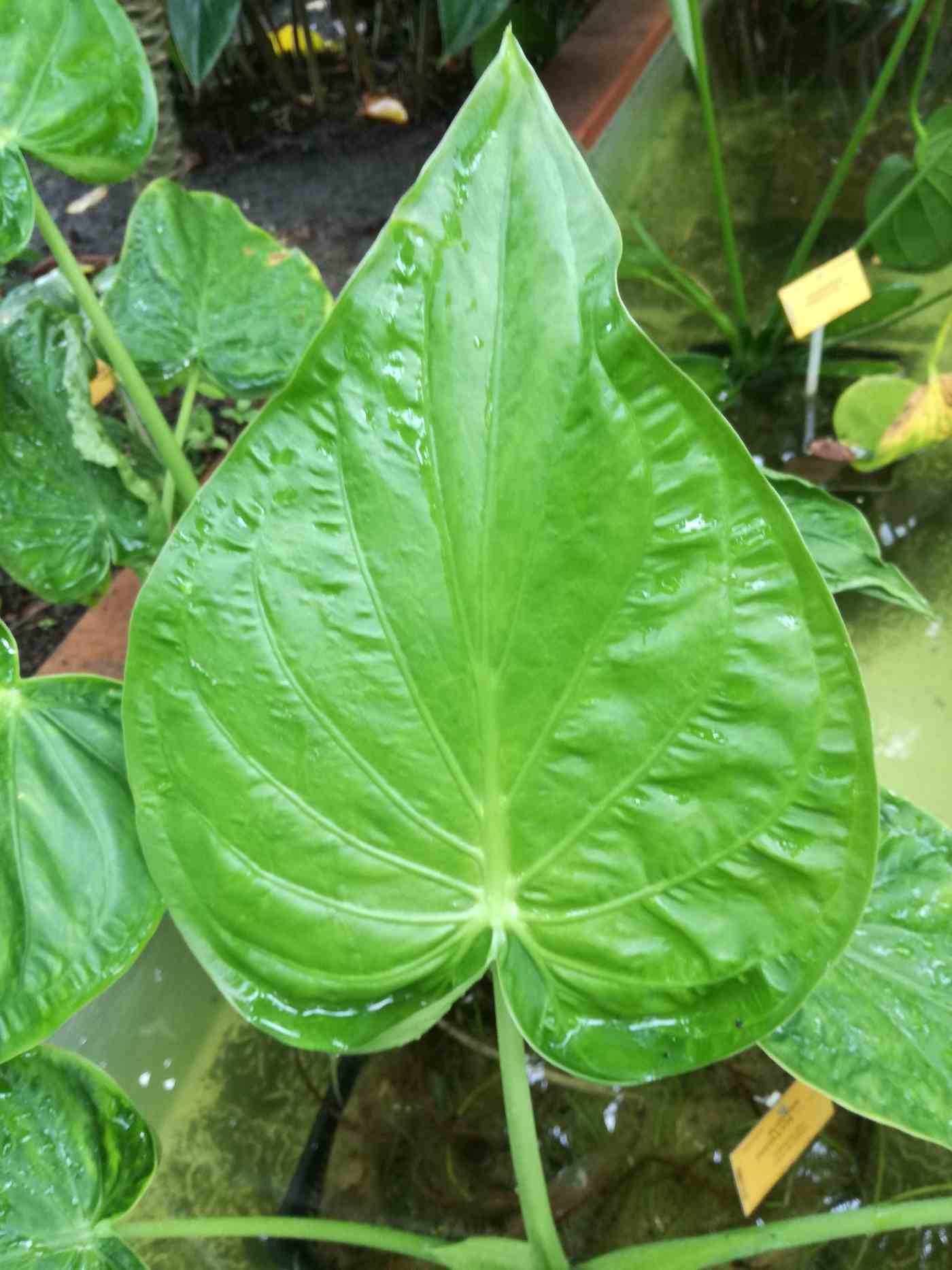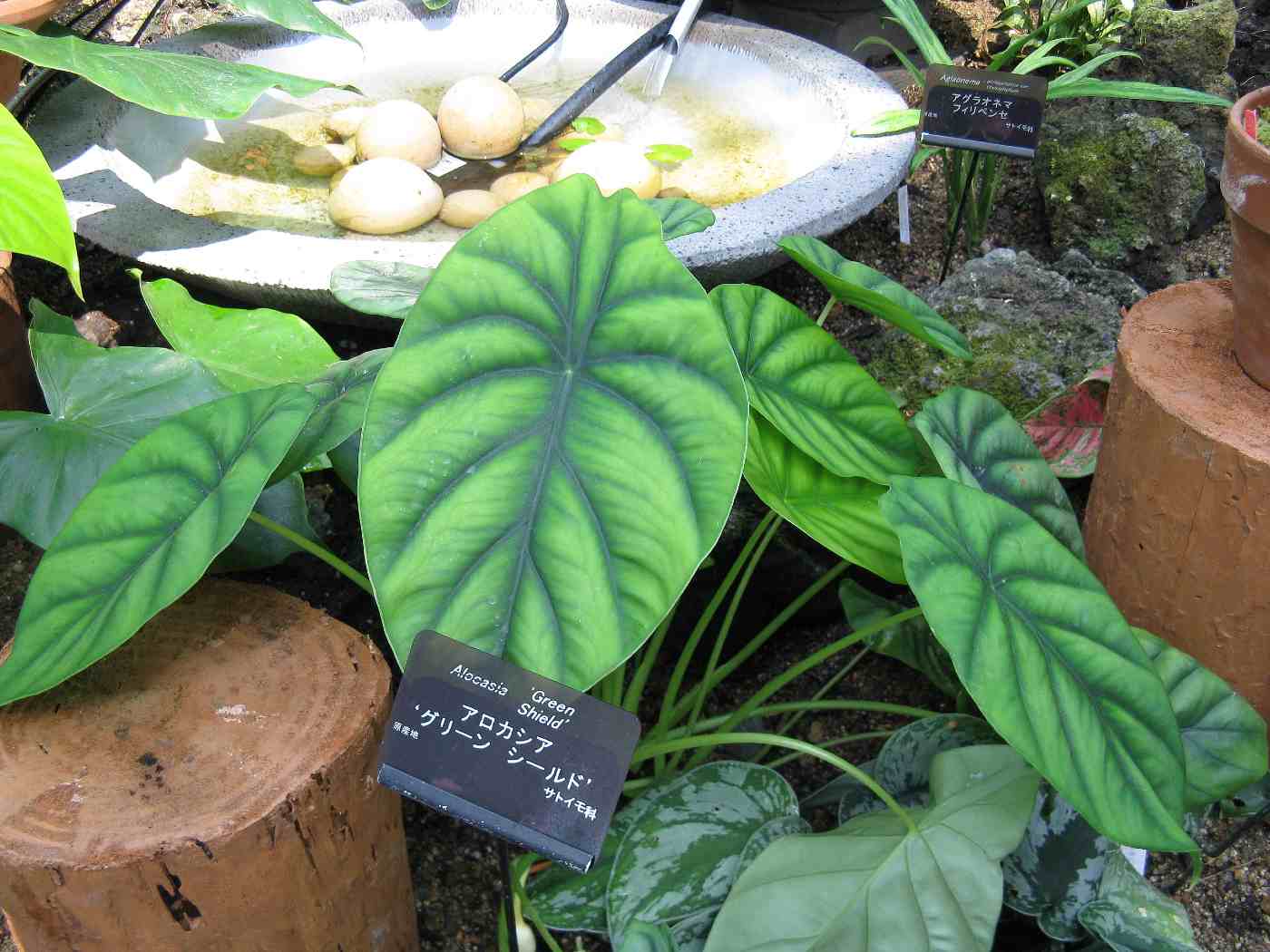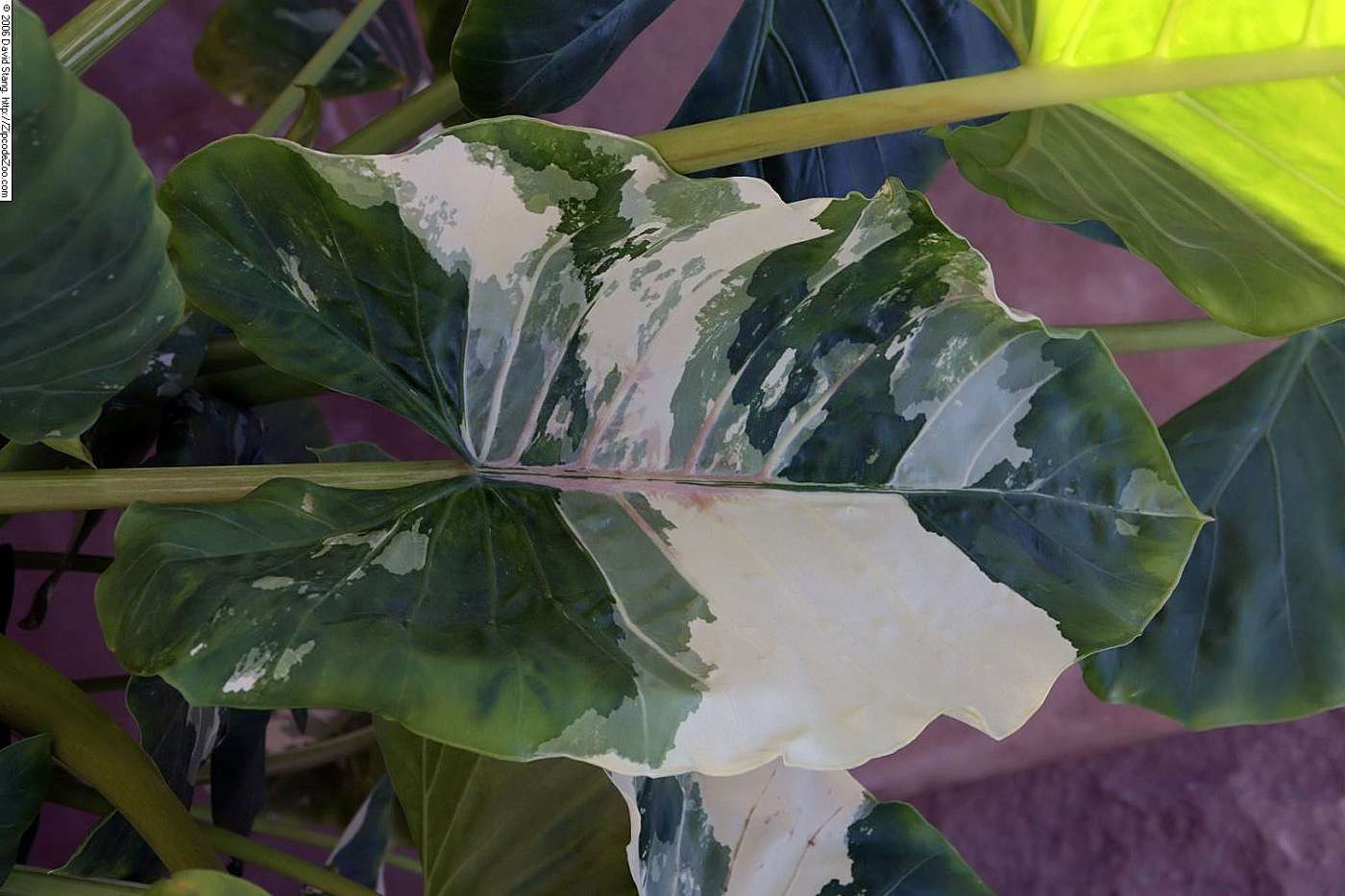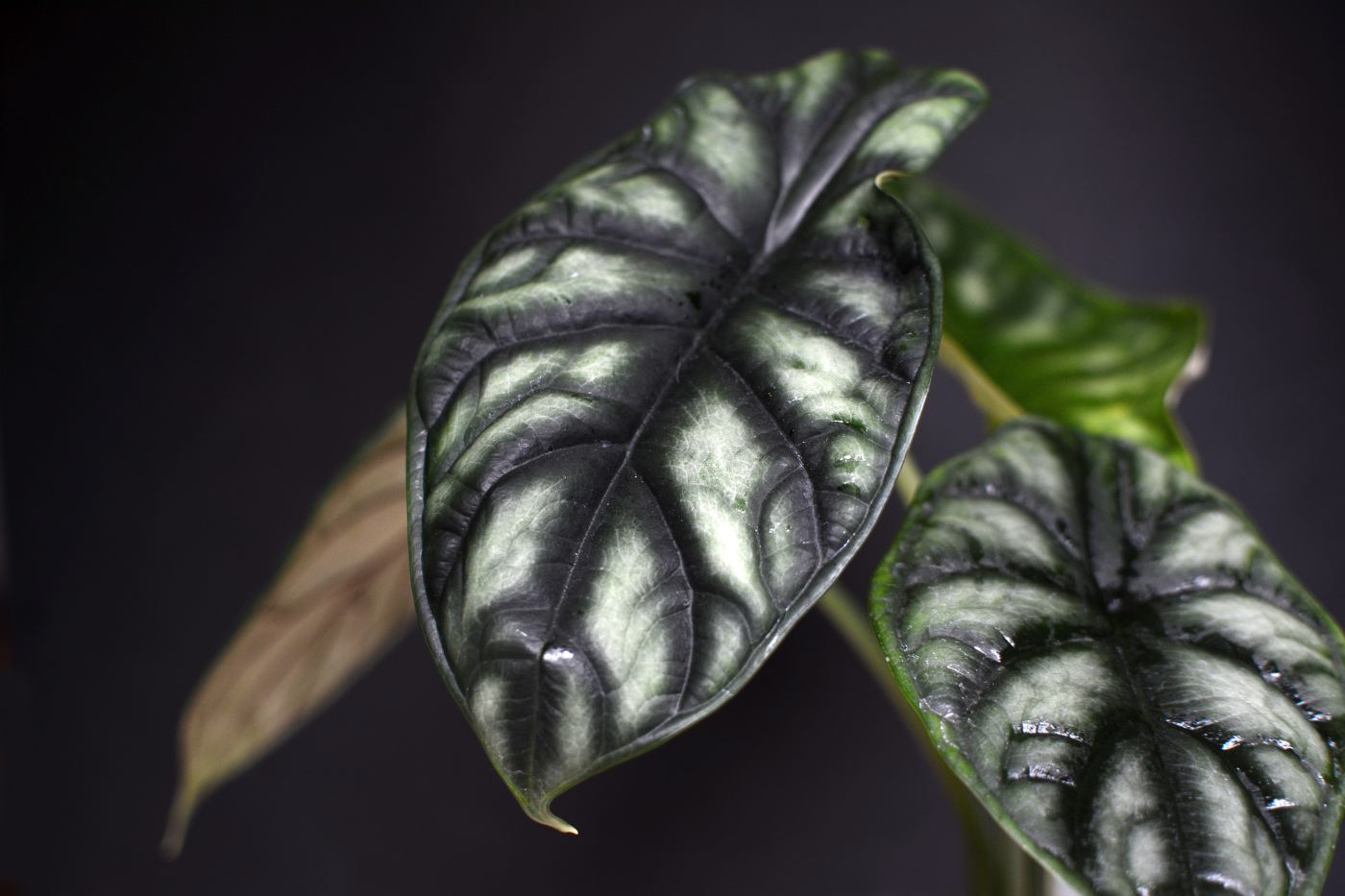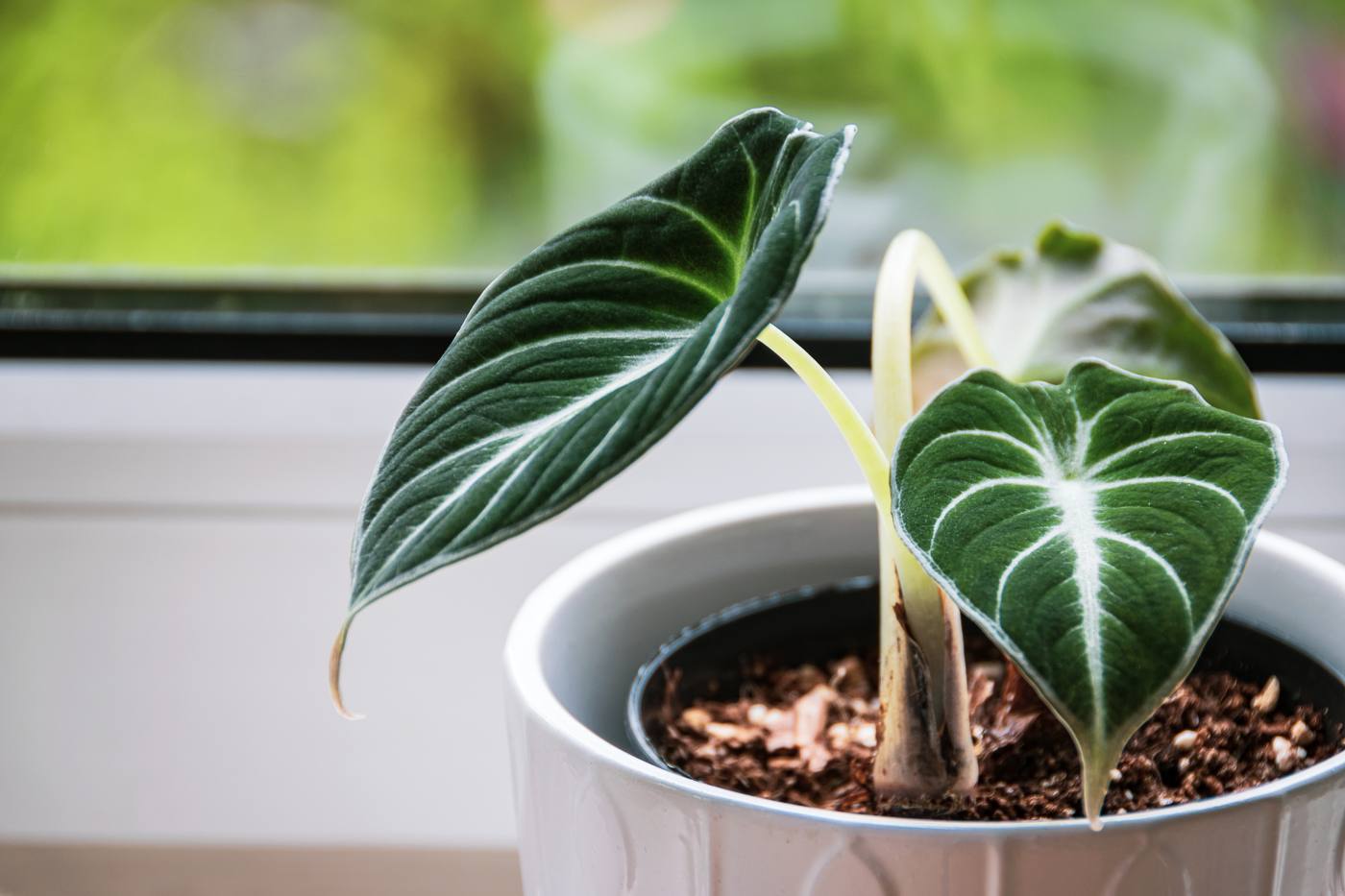For many people, the point of having indoor plants is to give a fresh, tropical feeling to our homes, and few plants bring in a lush rainforest vibe like Alocasia.
Alocasias also make fantastic garden plants if you happen to be lucky enough to live in an area where you can grow them (that’s typically USDA Zones 9-11). If not, you can have the best of both worlds, growing them in pots outdoors for the summer and overwintering them inside.
There are a few things to consider before bringing an Alocasia home:
- Many upright Alocasia varieties can grow 6 feet or more in a single season, which is either a blessing or a curse, depending on context, of course.
- Alocasias are toxic and should all be kept away from kids and pets.
- They’re often not easy to grow. They can be fussy about everything from light to soil to temperature to drafts and they need lots of watering.
- Like aglaonemas, they have underwhelming flowers. That’s fine, because Alocasias have lots of other things going for them, but if you want big, showy tropical flowers, this is not the plant for you.
Still keen? Let’s talk varieties.
How Many Varieties of Alocasia Are There?
When people think of Alocasias, they usually think of towering, large-leaved plants that look like they’ve stepped out of the Jurassic. There are many species and varieties of Alocasia, however, which may be more or less easy to find. Common Alocasia varieties like ‘Polly’ are staples at nurseries and garden centres anywhere, while rare Alocasia varieties usually need to be purchased online or from a specialty shop.
Below, we’ll show you 13 incredible Alocasia varieties with names and pictures, and we’ll include a little info on caring for these remarkable plants in case you want to take the plunge and grow one (or many) yourself.
Large Alocasia Varieties
Alocasia macrorrhizos (Giant Taro)
This is the plant many people think of when they think of Alocasia. It’s enormous, reaching 12 to 15 feet high, as well as 6 to 8 feet wide when grown outdoors. The leaves alone can be 6 feet long and 4 feet wide and are said to resemble elephants’ ears (hence the plant’s nickname “Elephant Ears”).
These bright green leaves are gently ruffled, with an elongated heart shape and deep veining. Whether you grow Giant Taro outside or indoors, keep this plant in partial shade—its leaves can burn in the sun. It prefers consistently moist, rich soils as well as moderate watering.
According to the Centre for Agriculture and Bioscience International (CABI), however, A. macrorrhizos grows in a variety of habitats, is listed as invasive in several countries and is even “considered a weed in Vietnam,” so it can handle some lapses in care.
Alocasia ‘Sarian’
With its oversized, sharp-edged leaves and contrasting white veins, ‘Sarian’ will be a real head-turner in your plant collection. It grows best in partial shade, although it will tolerate full sun. It needs well-draining soil that’s rich and moist.
This is not a plant for the inattentive waterer. It hates soggy soil, but it hates being dry even more, so keep to a regular schedule and watch leaves for any sign of curling or dryness.
‘Sarian’ is a big plant, growing between 5-10 feet high and 2-6 feet wide. If you grow it outdoors, it could grow even taller, but if left as a houseplant, it will stay on the smaller side. That said, you’ll still need to devote a lot of space to this guy.
Alocasia macrorrhiza ‘Stingray’
For something truly unique, there’s Alocasia ‘Stingray.’ One of the neatest Alocasia macrorrhiza varieties, ‘Stingray’s’ leaves do resemble the sea creature, and on their long stems, it’s easy to imagine them floating along an ocean current.
Keep ‘Stingray’ in bright, diffuse light and in rich, well-draining soil. They like to be warm, humid and consistently watered. These make great bathroom plants if your bathroom gets enough light. Otherwise, be prepared to mist these plants to keep them happy.
Be prepared for rapid growth, too. ‘Stingray’ is a fast grower and can reach 15 feet tall, as well as 8 feet wide when grown outside. Grown indoors it can still reach 4 feet.
Small Alocasia Varieties
Alocasia amazonica ‘Polly’
‘Polly’ is one of the easiest Alocasia amazonica varieties to find and it’s a great cultivar for folks who don’t have space for a houseplant that gets 8 feet wide. Which I imagine is most of us.
This plant is a cross between Alocasia longiloba ‘Watsonia’ and Alocasia sanderiana. ‘Polly’ reaches a modest 2 feet in height and can grow 10 inches wide. Other than the size difference, ‘Polly’ is very much like A. sanderiana. They’re both Alocasia arrowhead varieties with deeply waved edges and a dark green colour with light, contrasting veins.
Keep ‘Polly’ in bright indirect light and warm temps. The soil should be loose, well-draining and moist, although over the winter, you should allow a longer time between waterings.
Alocasia amazonica ‘Bambino’
If ‘Polly’ still isn’t small enough for your indoor garden, you can turn to dwarf Alocasia varieties like ‘Bambino.’ This plant is often confused with ‘Polly,’ and shares many of that plant’s best features.
‘Bambino’ has similar arrow-shaped leaves, with a deep green colour and contrasting light midribs and veins. It’s similarly compact, as well as slow growing. ‘Bambino’ reaches a mere 12 inches high and it tolerates lower light conditions better than some other varieties.
Like other Alocasias, this little guy likes high humidity, consistently moist soils and warm temperatures. If you have a small bathroom that gets a fair amount of light, ‘Bambino’ could be the perfect addition to it.
Alocasia sinuata
Also known as Quilted Dream, this small plant grows between 12 and 14 inches tall, making it one of the smallest indoor Alocasia varieties available. The plant gets its name from its beautifully textured leaves. Their rich, deep and slightly glossy colour are a big draw for Alocasia fans, too.
A. sinuata is more difficult to source. In the wild, the plant is listed as critically endangered on the International Union for Conservation of Nature (IUCN)’s Red List, although it’s cultivated around the world.
Should you get your hands on one of these beauties, remember to keep it warm and moist—they like very humid conditions. They can take medium or bright indirect light, but don’t tolerate direct sun or very low light conditions.
Green Alocasia Varieties
Alocasia cucullata
This variety goes by many names, including Buddha’s Hand, Buddha’s Palm, Hooded Dwarf and Hooded Elephant Ears. Its deep green, upright leaves make it a fantastic option for brightening up a corner, although be warned that corner will need to be a large one.
These plants grow fast and can reach 13 feet tall, with leaves that can grow a foot wide and 15 inches long. Fortunately, there’s a dwarf variety that grows to 3 feet for those who aren’t working with that kind of real estate.
More forgiving than other varieties, this Alocasia can tolerate a wider range of light conditions, as well as a little less care with watering. Keep your Buddha’s Hand in brighter light rather than darker, although as with other Alocasias, too much sunlight can harm the leaves.
Keep this plant moist by misting or taking it into the bathroom while you shower sometimes.
Alocasia wentii
Alocasia wentii features broad, dark green leaves with delicate tips and slightly waved edges. The undersides have a lovely purple hue, adding a little interest to this plant and earning it the nickname Purple Umbrella.
Like A. cucullata, A. wentii is a more forgiving variety of Alocasia. It doesn’t like low light conditions, but it can tolerate some direct early morning or late-day sunlight. Keep your plant moist, and grow it in light, airy soil that drains well. Although it can tolerate lower humidity levels, check the leaf edges for browning or curling and mist the plant if you see those signs of drying.
A. wentii is a reasonably sized plant, reaching about 3 feet tall and wide. Its leaves grow about a foot long, giving the plant a dramatic oversized feel without taking up too much room.
Alocasia clypeolata ‘Green Shield’
‘Green Shield’ is exactly the right name for this plant. Not only are the leaves shaped like their namesake, they’re quite thick and leathery, making this variety a bit hardier in the garden. The deeper green midribs and veins give some depth and subtle contrast to the leaves, as well.
It can reach 4 feet tall, although it grows more slowly than other Alocasia. Outdoors, ‘Green Shield’ can add some gorgeous foliage to your garden without overwhelming it. Indoors, you can expect the plant to reach 2.5-3 feet in height.
This plant can take more sunlight than many other Alocasia varieties, although it prefers filtered light. Likewise, it’s more tolerant when people forget to water it occasionally, although it needs rich soil that stays relatively moist. Grow in high humidity locations.
Colourful Alocasia Varieties
Alocasia cuprea ‘Red Secret’
Red and pink alocasia varieties are on the rarer side but ‘Red Secret’ is among the easier to find. The leaves have a metallic look to them, with reddish purple undersides and surfaces that range from deep green to red.
The stems are lighter in colour and that, coupled with the plant’s light sheen and contrasting veins, make it eye-catching from every angle. Slow-growing and compact, ‘Red Secret’ can reach about 3 feet tall and 2.5 feet wide, although it might not reach that height for many years.
This is not a plant for dry homes. It only thrives in high humidity and requires a regular watering schedule. It’s also one of those Alocasia cuprea varieties that really needs filtered light—too much and the leaves will burn. Moist, rich but loose soil is a must, as is misting and a consistently warm environment.
Alocasia macrorrhiza ‘Variegata’
Variegated Alocasia varieties are very rare plants that are much admired, for obvious reasons. The striking variegation here is a real departure from other Alocasias, although the plant shares their typical large, broad leaf structure.
You’ll need to pay close attention to light if you decide to bring one of these lovelies home. They need bright, filtered light to really put their best faces forward. Direct sunlight will damage the leaves, but too much shade will make the variegation fade. You’ll also need to water them consistently and keep them well fertilized.
Variegated Alocasias can grow 10 feet tall when grown outdoors. Keeping them inside or in containers will curb that growth somewhat.
Alocasia ‘Dragon Scale’
Silvery-grey, with a metallic sheen and a tough, thickened texture, the leaves of this plant earn their name. The colours will deepen as the plant matures, making it more striking as it grows.
Like other Alocasia baginda varieties, ‘Dragon Scale’ likes very loose, well-draining soil. This is a temperamental plant that needs bright, indirect light and careful attention to moisture levels. Keep out of direct sunlight if you grow it outdoors.
‘Dragon Scale’ is one of the smaller Jewel Alocasia varieties, reaching about 1.5 feet tall and wide. Start it in a larger container that it can grow into—it hates being repotted.
Alocasia reginula ‘Black Velvet’
Black Alocasia varieties are also becoming more and more popular, and although ‘Black Velvet’ isn’t the darkest you can find, it’s one of the best. Its dark, velvety leaves beautifully offset the pale veins, creating a high-impact look with subtle texture.
This compact plant will only reach about 1.5 feet, making it more versatile than some other options. ‘Black Velvet’ is also more flexible, tolerating lower light conditions and humidity levels than some other Alocasia velvet varieties will. It will insist, however, on well-draining soil that’s moist but not wet. It’s also firm in wanting a warm indoor environment that’s free from drafts.
Feature image, Image 1, 3, 4, 8, 10, 12, 13: Depositphotos; Image 2: Forest and Kim Starr; Image 5: Leonora (Ellie) Enking; Image 6: Obsidian Soul; Image 7: Jungle Rebel; Image 9: KENPEI; Image 11: David J. Stang
